Teleostei (teleosts) >
Anguilliformes (Eels and morays) >
Myrocongridae (Atlantic red eels)
Etymology: Myroconger: Greek, myros, -ou = male of morey eel + Latin, conger = conger (Ref. 45335); prolixus: From the Latin prolixus, "long bodied"..
Environment: milieu / climate zone / depth range / distribution range
Ecology
Marine; bathydemersal; depth range 260 - 280 m (Ref. 26785). Deep-water
Western Pacific: off New Caledonia, Kaiyo Maru Seamount.
Size / Weight / Age
Maturity: Lm ? range ? - ? cm
Max length : 38.3 cm TL (female)
Short description
Morphology | Morphometrics
Dorsal
soft rays
(total): 398;
Anal
soft rays: 239;
Vertebrae: 147. very slender body, relatively long snout, very slender neurocranium, prominent and sharp teeth, especially those on intermaxillary and inner row of maxilla and dentary; precaudal vertebrae 71.
Unique female specimen, with ova, trawled at the Kaiyo Maru Seamount, off New Caledonia (Ref. 26785).
Life cycle and mating behavior
Maturity | Reproduction | Spawning | Eggs | Fecundity | Larvae
Castle, P.H.J. and P. Béarez, 1995. Two new species of Myroconger (Anguilliformes, Myrocongridae) from the Pacific Ocean. Cybium 19(3):211-222. (Ref. 26785)
IUCN Red List Status (Ref. 130435)
Threat to humans
Harmless
Human uses
Fisheries: of no interest
More information
Common namesSynonymsMetabolismPredatorsEcotoxicologyReproductionMaturitySpawningSpawning aggregationFecundityEggsEgg development
Age/SizeGrowthLength-weightLength-lengthLength-frequenciesMorphometricsMorphologyLarvaeLarval dynamicsRecruitmentAbundanceBRUVS
ReferencesAquacultureAquaculture profileStrainsGeneticsElectrophoresesHeritabilityDiseasesProcessingNutrientsMass conversion
Tools
Special reports
Download XML
Internet sources
Estimates based on models
Preferred temperature (Ref.
123201): 11.5 - 16.2, mean 15.1 °C (based on 203 cells).
Phylogenetic diversity index (Ref.
82804): PD
50 = 0.5625 [Uniqueness, from 0.5 = low to 2.0 = high].
Bayesian length-weight: a=0.00102 (0.00046 - 0.00225), b=3.06 (2.88 - 3.24), in cm total length, based on all LWR estimates for this body shape (Ref.
93245).
Trophic level (Ref.
69278): 3.7 ±0.6 se; based on size and trophs of closest relatives
Fishing Vulnerability (Ref.
59153): Low to moderate vulnerability (28 of 100).
